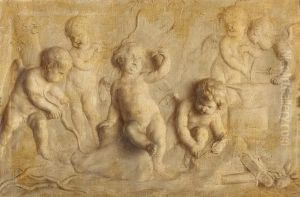Maerten Jozef Geeraerts Paintings
Maerten Jozef Geeraerts was a Flemish artist known for his work as an engraver and draftsman in the 18th century. Born in 1707 in Antwerp, Belgium, which was then part of the Spanish Netherlands, Geeraerts came from a region with a rich artistic heritage that had produced baroque masters such as Peter Paul Rubens and Anthony van Dyck in the previous century.
Although not as widely recognized as his predecessors, Geeraerts made a name for himself in the art world through his intricate engravings and detailed drawings. He was a part of the artistic movement that followed the baroque period, and his work often reflected the transition in artistic styles that was occurring during his lifetime, including elements of the Rococo and early Neoclassicism.
Geeraerts’ works were primarily religious and allegorical in nature, and he is known to have created engravings for book illustrations, including frontispieces and other decorative elements. His engravings were often based on the works of other painters, which was a common practice at the time for engravers who worked to disseminate the designs and compositions of well-known artists through prints.
Living through a period of significant political and social changes, including the Austrian Succession and the beginning of the Industrial Revolution, Geeraerts’ life and work were potentially influenced by the shifting cultural landscape of Europe in the 18th century. Nevertheless, specific details about his personal life, training, and influences are less documented than those of his more famous contemporaries.
Maerten Jozef Geeraerts passed away in 1791, leaving behind a body of work that contributes to our understanding of the artistic transitions of the 18th century. His engravings continue to be of interest to art historians and collectors who study the period and the dissemination of artistic ideas through printmaking.
